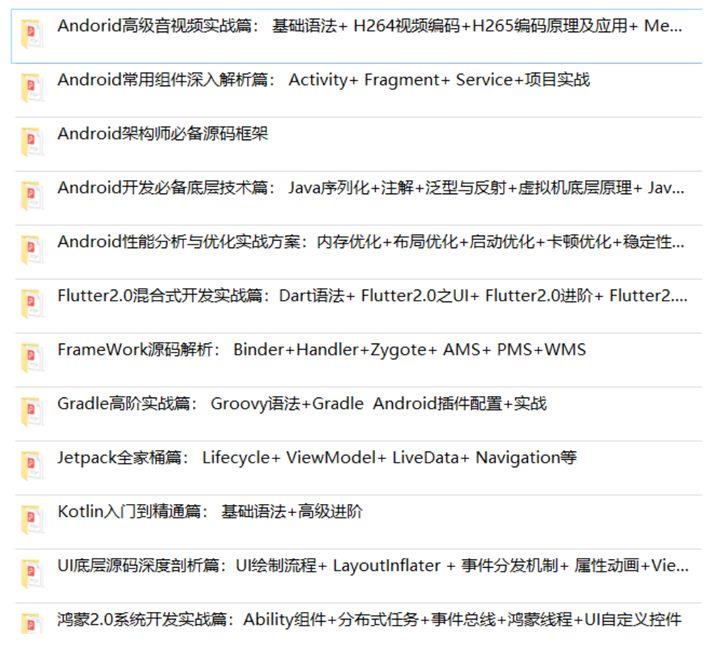Android 中的 NDK 到底是什么?(详细解析+案例实战)
Posted Android每日一讲
tags:
篇首语:本文由小常识网(cha138.com)小编为大家整理,主要介绍了Android 中的 NDK 到底是什么?(详细解析+案例实战)相关的知识,希望对你有一定的参考价值。
NDK 提供了一系列的工具,帮助开发者快速开发 C (或 C++ )的动态库,并能自动将 so 和 java 应用一起打包成 apk;这些工具对开发者的帮助是巨大的

什么是 NDK ?
Android 原生开发包 NDK(Native Delopment kits )将用于 Android 平台上的 C++ 开发
Android NDK 是 Android 软件开发包(SDK)的相关工具集,用来扩展 android SDK 的功能,从而是开发人员能够使用机器代码生成的编程语言(如 C、C++ 和汇编语言)实现一些对代码行要求较高的模块并将这些模块嵌入到 Android 应用程序中
众所周知,Android 程序运行在 Dalvik 虚拟机中,NDK 允许用户使用类似 C / C++ 之类的原生代码语言执行部分程序
NDK 的定义
- Android NDK 不是一个单独的工具: 它是一个包含API、交叉编译器、链接程序、调试器、构建工具、文档和实例应用程序的综合工具集
- 在 Android 的官方文档上是这么解释 NDK 的:“原生开发套件 (NDK) 是一套工具,使您能够在 Android 应用中使用 C 和 C++ 代码,并提供众多平台库,您可使用这些平台库管理原生 Activity 和访问物理设备组件;例如传感器和轻触输入”
- NDK 是一个 Android 官方提供的一个开发套件与 Android SDK 相对应,NDK 是原生开发套件,而 SDK 是 JAVA 开发套件。NDK 使得 Android 应用可以利用 C++ 语言高效的计算性能,进一步提升App的性能,降低延迟。
说道这里,大家肯定要问 NDK 有那些应用场景,我为什么要用 NDK 呢,用 JAV 不行吗?
下面列举一些NDK 的应用场景
重用一些现成的库,例如已经用 C/C++ 编写好的 openCV 库
前面提到的高性能计算,例如很多 Bitmap 的处理到放在 NDK 进行处理
一些敏感信息的保护,例如密钥等信息(密钥等信息还是要经过加盐才能放到 NDK 中,不然还是
会有别反编译的风险)
知道了应用场景,大家肯定已经摩拳擦掌准备试一试了,先别着急。欲善其事,先利其器;以下给出了开发 NDK 的三大利器;
NDK 的三大开发组件
-
NDK Android 原生开发套件
-
CMAKE 外部编译工具
-
LLDB 原生代码调试工具
NDK 开发优点
- 利用 NDK 开发的库,不容易被反编译,保密性,安全性都提高了
- 很多开源工程和大工程都是 C/C++ 代码写的
- C/C++ 的代码运行速度和效率都比 Java 快很多
Android NDK 开发步骤
(1)JNI 接口设计;
(2)使用 C/C++ 本地实现方法;
(3)生成动态链接库;
(4)将动态链接库复制到 Java 工程,运行 Java 程序
NDK 基础实践
CMake
推荐使用 CMake 而不是传统 NDK-build 的方式,既然都用新的,自然有它的道理,简单方便
有很多人在配置 CMakeLists.txt 时编译不通过,是自己的问题吗?当然,难不成还是它的问题吗?
首先我们想要打出一个.so文件来,我们肯定是要先写Java代码
第一步:
解释一下这里代码的意思: native 这个就是我们提供出去的方法,这个方法到时候要和 .c 文件里面或者 .cc 文件里面的方法名一致,我们再静态中去加载我们打出来的 .so 文件, 这里的参数名字不是 .so 文件的名字,而是我们在打包的时候配置的名字,这个配置下面介绍
public class JniKit
//这里的方法名如果报错那是正常的,不影响
public static native int calculate(int num);
static
System.loadLibrary("JniDemo");
第二步:
我们需要根据这个写好的 Java 文件来生成一个 .h 文件,生成 .h 文件是通过 javah 来执行的,这里我之前尝试了各种办法,但是网上说的办法都没办法成功,都是报错说找不到类文件,我觉得这里可能和我的文件的方法有点问题,等会我把我现在成功的文件目录贴出来,执行的代码
javah -classpath D:\\360PhoneInfo\\small-video-record-master\\SmallVideoRecord2\\testndk\\build\\intermediates\\classes\\debug -d jni
com.example.testndk.JniKit
根据这个代码我得到了.h文件,包括这个jni文件夹也是通过-d jni这个生成出来的,不是自己创建的
第三步:
现在我们有了 .h 文件了,接下来就是写 .c 文件了,当然了我不会 c 语言,所以这里拿了一个测试的来用, c 这部分的不用关注太多 include中指向你创建的 .h 头文件 Java_com_example_testndk_JniKit_calculate;Java 包名类名方法名(参数)
#include "com_example_testndk_JniKit.h"
JNIEXPORT jint JNICALL Java_com_example_testndk_JniKit_calculate(JNIEnv *env, jclass cls, jint num)
return num * num;
第四步:
现在 .h.c 文件我们都有了,接下来就是最关键的一步了,生成 .so 文件了,这一步,我查阅了很多资料,折磨了两个小时,才弄出来,这里我不知道是不是我的配置有问题,还是什么问题,反正我在 build.gradle 配置,然后去 Make Project 生成了很久没有生成出来,这里我是用命令行中的 ndk-build 来解决的
解决方式如下:
1、建立一个 Android.mk 文件
LOCAL_MODULE 表示模块名称 LOCAL_SRC_FILES 表示需要参与编译的源文件,就是我们的 c 除了这两个,其他照搬即可
LOCAL_PATH := $(call my-dir)
include $(CLEAR_VARS)
LOCAL_MODULE := JniDemo
LOCAL_SRC_FILES := jni_test.c
LOCAL_LDLIBS +=-L$(SYSROOT)/usr/lib -lm -llog
include $(BUILD_SHARED_LIBRARY)
2、建立一个Application.mk文件
需要注意的东西都写在里面了,以逗号分割cpu指令
APP_STL := gnustl_static
APP_CPPFLAGS := -frtti -fexceptions
APP_ABI := armeabi-v7a #这句是设置生成的cpu指令类型,提示,目前绝大部分安卓手机支持armeabi,libs下太多类型,编译进去 apk 包会过大
APP_PLATFORM := android-8 #这句是设置最低安卓平台,可以不弄
3、因为我的这两个文件是和 .h.c 放在同一个文件夹中 -jni,所以我们要执行 ndk-build 命令需要进入到 jni 文件夹下再去执行
这里给一个范例,传入字符串调用 so 库中的方法
public class JniUtil
static
System.loadLibrary("JniUtil");
public static native void initialize(String string, String logPath);
extern "C"
JNIEXPORT void JNICALL Java_com_kxqin_livingrecognitiondemo_JniUtil_initialize
(JNIEnv* env, jclass jclazz ,jstring jstring1, jstring logPath)
//获取字符串指针,必须使用指针,不能使用char strContent[],因为GetStringUTFChars()返回值为const char *;
const char *str = env->GetStringUTFChars(jstring1, JNI_FALSE);
const char *path = env->GetStringUTFChars(logPath, JNI_FALSE);
std::string log = path;
std::string string = str;
//头文件中的方法
defence_native_initialize(string, log);
//LOGD("initialize is success");
然后直接 JniUtil.initialize (String1,String2) 就可以调用到 cpp 中的方法了
试试在 Terminal 中输入
adb logcat | ndk-stack -sym app\\build\\intermediates\\cmake\\debug\\obj$ABI
将 $ABI 换为你的 ABI,正常情况下在模拟器上使用就是 x86,真机就是 armabi-v7a 或 arm64-v8a,
或许能帮你解决不少麻烦
总结
通过前面详细的讲解,我想各位读者应该对 NDK 有一个清晰的认识了下面让我在最后用一句话总结那就是NDK 则是 Android 妈咪谷歌提供的一种开发工具套件
如果想学习更多 Android 进阶知识或者获取音视频相关技术文档,请私信发送 “进阶” 即可直达;里面包含了面试资源系统整理分享,Java 语言进阶和 Kotlin 语言与 Android 相关技术内核, APP 开发框架知识、 Android 前沿技术,高级 UI、Gradle 等技术文档


好了,以上就是今天要分享的内容,大家觉得有用的话,可以点赞分享一下;如果文章中有什么问题欢迎大家指正;欢迎在评论区或后台讨论哈~
Android NDK pthreads详细使用
这个pthread.h文件可以在NDK环境里创建子线程,并对线程能够做出互斥所、等待、销毁等控制。
写这个博客的原因是我要写如何使用FFmpeg播放视频,因为同时需要播放音频和视频所以需要开启线程,并设置生产者和消费者的关系。
好了直接上整体
1.开启和销毁线程
pthread_create函数能够创建线程,第一个参数是线程的引用,第二个是线程的属性,一般为NULL,第三个为线程运行的函数,第四个是给线程运行函数的参数
pthread_create又是开启线程,只要运行了这个函数线程就会运行起来,也就是运行第三个参数所代表的函数
pthread_t pthreads;
pthread_create(&pthreads, NULL, threadFunc, (void *) "zzw");等待线程完成和返回参数,这个如果开启线程只有一个可以不写,但是如果有多个线程这个就必须要写,不写的话只会运行第一个线程
int retvalue;
pthread_join(pthreads,(void**)&retvalue);
if(retvalue!=0){
__android_log_print(ANDROID_LOG_ERROR,"hello","thread error occurred");
}我们再来看看线程运行函数,这个他可以获取参数,并且能能够提前结束线程
void threadFunc(void arg){
char* str=(char*)arg;
for(int i=0;i<3;i++){
__android_log_print(ANDROID_LOG_VERBOSE,"hello","i = %d arg = %s",i,str);
//线程自杀,需要返回参数
//pthread_exit((void*)2);
//线程他杀
//pthread_cancel()
}
return (void *) 0;}
完整例子代码
#include <jni.h>
#include <string>
#include <android/log.h>
#define LOGE(FORMAT,...) android_log_print(ANDROID_LOG_ERROR,"LC XXX",FORMAT,##VA_ARGS__);
extern "C"
JNIEXPORT jstring
JNICALL
Java_com_example_zth_ndkthread_MainActivity_stringFromJNI(
JNIEnv env,
jobject / this */) {
std::string hello = "Hello from C++";
return env->NewStringUTF(hello.c_str());
}
void threadFunc(void arg){
char* str=(char*)arg;
for(int i=0;i<3;i++){
__android_log_print(ANDROID_LOG_VERBOSE,"hello","i = %d arg = %s",i,str);
//线程自杀,需要返回参数
//pthread_exit((void*)2);
//线程他杀
//pthread_cancel()
}
return (void *) 0;}
extern "C"
JNIEXPORT void JNICALL
Java_com_example_zth_ndkthread_MainActivity_startNativeThread(JNIEnv* env, jobject thiz,jint count) {
pthread_t pthreads;
pthread_create(&pthreads, NULL, threadFunc, (void *) "zzw");
int retvalue;
pthread_join(pthreads,(void**)&retvalue);
if(retvalue!=0){
__android_log_print(ANDROID_LOG_ERROR,"hello","thread error occurred");
}}
2.互斥锁
互斥锁指的是它能够锁住一段代码,使得这段代码在解锁之前不能再被执行一次,
初始化
pthread_mutex_t pthread_mutex;
if(pthread_mutex_init(&pthread_mutex,NULL)!=0)
return;开启线程时把互斥锁传给线程运行函数
for(int i=0;i<count;i++){
pthread_create(&pthreads[i],NULL,threadFunc,&pthread_mutex);
}我们再来看看线程运行函数
取出互斥锁并上锁
pthread_mutex_t* pthread_mutex=(pthread_mutex_t*)arg;
pthread_mutex_lock(pthread_mutex);然后一段代码
for(int i=0;i<3;i++){
__android_log_print(ANDROID_LOG_VERBOSE,"hello","i = %d",i);
}
__android_log_print(ANDROID_LOG_VERBOSE,"hello","————————————");解锁
pthread_mutex_unlock(pthread_mutex);
最后销毁互斥锁
pthread_mutex_destroy(&pthread_mutex);运行效果如下
03-02 14:25:58.346 10022-10077/com.example.zth.ndkthread V/hello: i = 0
03-02 14:25:58.346 10022-10077/com.example.zth.ndkthread V/hello: i = 1
03-02 14:25:58.346 10022-10077/com.example.zth.ndkthread V/hello: i = 2
03-02 14:25:58.346 10022-10077/com.example.zth.ndkthread V/hello: ------------------------
03-02 14:25:58.346 10022-10078/com.example.zth.ndkthread V/hello: i = 0
03-02 14:25:58.346 10022-10078/com.example.zth.ndkthread V/hello: i = 1
03-02 14:25:58.346 10022-10078/com.example.zth.ndkthread V/hello: i = 2
03-02 14:25:58.346 10022-10078/com.example.zth.ndkthread V/hello: ------------------------
03-02 14:25:58.347 10022-10079/com.example.zth.ndkthread V/hello: i = 0
03-02 14:25:58.347 10022-10079/com.example.zth.ndkthread V/hello: i = 1
03-02 14:25:58.347 10022-10079/com.example.zth.ndkthread V/hello: i = 2
03-02 14:25:58.347 10022-10079/com.example.zth.ndkthread V/hello: ————————————
如果我们没有加锁呢
pthread_mutex_t* pthread_mutex=(pthread_mutex_t*)arg;// pthread_mutex_lock(pthread_mutex);
for(int i=0;i<3;i++){
android_log_print(ANDROID_LOG_VERBOSE,"hello","i = %d",i);
}
android_log_print(ANDROID_LOG_VERBOSE,"hello","------------------------");
// pthread_mutex_unlock(pthread_mutex);
结果如下
03-02 14:36:50.035 13815-13993/com.example.zth.ndkthread V/hello: i = 0
03-02 14:36:50.035 13815-13993/com.example.zth.ndkthread V/hello: i = 1
03-02 14:36:50.035 13815-13993/com.example.zth.ndkthread V/hello: i = 2
03-02 14:36:50.035 13815-13993/com.example.zth.ndkthread V/hello: ------------------------
03-02 14:36:50.035 13815-13994/com.example.zth.ndkthread V/hello: i = 0
03-02 14:36:50.035 13815-13994/com.example.zth.ndkthread V/hello: i = 1
03-02 14:36:50.035 13815-13994/com.example.zth.ndkthread V/hello: i = 2
03-02 14:36:50.035 13815-13995/com.example.zth.ndkthread V/hello: i = 0
03-02 14:36:50.035 13815-13994/com.example.zth.ndkthread V/hello: ------------------------
03-02 14:36:50.035 13815-13995/com.example.zth.ndkthread V/hello: i = 1
03-02 14:36:50.035 13815-13995/com.example.zth.ndkthread V/hello: i = 2
03-02 14:36:50.035 13815-13995/com.example.zth.ndkthread V/hello: ------------------------
所以互斥锁是先让一个线程做完,然后另外一个线程做。
例子代码:
#include <jni.h>
#include <string>
#include <android/log.h>
#include "pthread.h"
#define LOGE(FORMAT,...) android_log_print(ANDROID_LOG_ERROR,"LC XXX",FORMAT,##VA_ARGS__);
extern "C"
JNIEXPORT jstring
JNICALL
Java_com_example_zth_ndkthread_MainActivity_stringFromJNI(
JNIEnv env,
jobject / this */) {
std::string hello = "Hello from C++";
return env->NewStringUTF(hello.c_str());
}
void threadFunc(void arg){
pthread_mutex_t* pthread_mutex=(pthread_mutex_t*)arg;
pthread_mutex_lock(pthread_mutex);
for(int i=0;i<3;i++){
__android_log_print(ANDROID_LOG_VERBOSE,"hello","i = %d",i);
}
__android_log_print(ANDROID_LOG_VERBOSE,"hello","------------------------");
pthread_mutex_unlock(pthread_mutex);
return (void *) 0;}
extern "C"
JNIEXPORT void JNICALL
Java_com_example_zth_ndkthread_MainActivity_startNativeThread(JNIEnv* env, jobject thiz,jint count) {
pthread_mutex_t pthread_mutex;
if(pthread_mutex_init(&pthread_mutex,NULL)!=0)
return;
pthread_t pthreads[count];
for(int i=0;i<count;i++){
pthread_create(&pthreads[i],NULL,threadFunc,&pthread_mutex);
}
for(int i=0;i<count;i++){
int retvalue=0;
pthread_join(pthreads[i],(void**)&retvalue);
if(retvalue!=0){
__android_log_print(ANDROID_LOG_ERROR,"hello","thread error occurred");
}
}
pthread_mutex_destroy(&pthread_mutex);}
3.条件变量
视频解码的绘制使用的就是生产者—消费者的模式。比如说我们生产者生成的产品,放到一个队列里面,当生产者生产出产品的时候就会发送信号通知消费者去消费
这个条件变量能够唤醒线程运行
初始化
pthread_cond_init(&c,NULL);
开启生成者线程和消费者线程
pthread_create(&thread_producer, NULL, produce, (void *) "producer");
pthread_create(&thread_comsumer, NULL, comsume, (void *) "comsumer");循环生产产品,然后提醒消费者
for(;;){
pthread_mutex_lock(&m);
productNum++;
__android_log_print(ANDROID_LOG_VERBOSE,"hello","i = %d",productNum);
pthread_cond_signal(&c);
pthread_mutex_unlock(&m);
}消费者线程如果发现没有产品就等待条件变量提醒,,如果有产品就消费掉
pthread_mutex_lock(&m);
while(productNum == 0){
pthread_cond_wait(&c,&m);
}
productNum--;
__android_log_print(ANDROID_LOG_VERBOSE,"hello","i = %d",productNum);
pthread_mutex_unlock(&m);注意生成者与消费者线程运行的全过程都在互斥锁下,都是按顺序一一执行的,这样对于全局变量productNum的计算就不会错误,并且通过一个线程执行pthread_cond_signal来触发另一个线程执行
例子代码
#include <jni.h>
#include <string>
#include <android/log.h>
#include "pthread.h"
#define LOGE(FORMAT,...) android_log_print(ANDROID_LOG_ERROR,"LC XXX",FORMAT,##VA_ARGS__);
extern "C"
JNIEXPORT jstring
JNICALL
Java_com_example_zth_ndkthread_MainActivity_stringFromJNI(
JNIEnv env,
jobject / this */) {
std::string hello = "Hello from C++";
return env->NewStringUTF(hello.c_str());
}
int productNum = 0;
pthread_mutex_t m;
pthread_cond_t c;
void produce(void arg){
char no = (char)arg;
for(;;){
pthread_mutex_lock(&m);
productNum++;
__android_log_print(ANDROID_LOG_VERBOSE,"hello","i = %d",productNum);
pthread_cond_signal(&c);
pthread_mutex_unlock(&m);
}}
void comsume(void arg){
char no = (char)arg;
for(;;){
pthread_mutex_lock(&m);
while(productNum == 0){
pthread_cond_wait(&c,&m);
}
productNum--;
__android_log_print(ANDROID_LOG_VERBOSE,"hello","i = %d",productNum);
pthread_mutex_unlock(&m);
}}
extern "C"
JNIEXPORT void JNICALL
Java_com_example_zth_ndkthread_MainActivity_startNativeThread(JNIEnv* env, jobject thiz,jint count) {
pthread_mutex_init(&m,NULL);
pthread_cond_init(&c,NULL);
pthread_t thread_producer;
pthread_t thread_comsumer;
pthread_create(&thread_producer, NULL, produce, (void *) "producer");
pthread_create(&thread_comsumer, NULL, comsume, (void *) "comsumer");
pthread_join(thread_producer,NULL);
pthread_join(thread_comsumer,NULL);
pthread_mutex_destroy(&m);
pthread_cond_destroy(&c);}
参考文章
https://www.jianshu.com/p/453d12c16885
http://blog.csdn.net/lxmhuendan/article/details/11967593
以上是关于Android 中的 NDK 到底是什么?(详细解析+案例实战)的主要内容,如果未能解决你的问题,请参考以下文章